Let’s play a quick word association game. What food do you associate with healthy bones? Is it milk? And what does milk have in it that builds strong bones? Most people think “calcium.”
When you think of healthy bones, you probably flash back to the incredibly successful “Got Milk?” ad campaign, which began flooding television and other media in 1993. Its message? Drinking calcium-rich cow’s milk is the best thing you can do for your bones. Boomers and Gen Xers learned that dairy was one of the “four basic food groups” because calcium is so important to skeletal health.
It turns out that all this marketing is just that: marketing — not science. Not only is dairy consumption not the savior of bone health, but drinking milk actually appears to increase the risk of bone fractures as you age. And there are other much more important, if less well-publicized factors, that have a much greater impact on osteoporosis prevention and the strength of your skeleton.
What Is Osteoporosis?
Osteoporosis is often called a silent disease because many people don’t know they have it until they end up with a fracture. Others may notice their spine starting to curve, or that they’re getting shorter, which can indicate bone loss.
The name “osteoporosis” translates to “porous bone.” Osteoporosis is a bone disease that occurs when your body loses too much bone, makes too little bone, or both. As a result, bones become weaker, spongier, and prone to fracturing. This means that they may break much more easily if you fall. In serious cases, osteoporosis can put your bones at risk for breaking from minor things like sneezing or bumping into something that would otherwise just cause a small bruise.
According to the National Osteoporosis Foundation, osteoporosis causes two million broken bones and $19 billion in related healthcare costs annually. Currently, there are nearly 54 million Americans living with osteoporosis.
Although osteoporosis mostly affects older people, the process of bone loss typically begins much earlier in life. Bone mass stops increasing around age 30, after which lifestyle choices and habits can either retain healthy bones or start promoting bone weakness and porosity that may one day lead to a clinical diagnosis. That’s why, even if you’re in your 20s, 30s, or 40s, it’s important to adopt habits that will set you up for a robust, bone-healthy old age.
What Causes Osteoporosis?
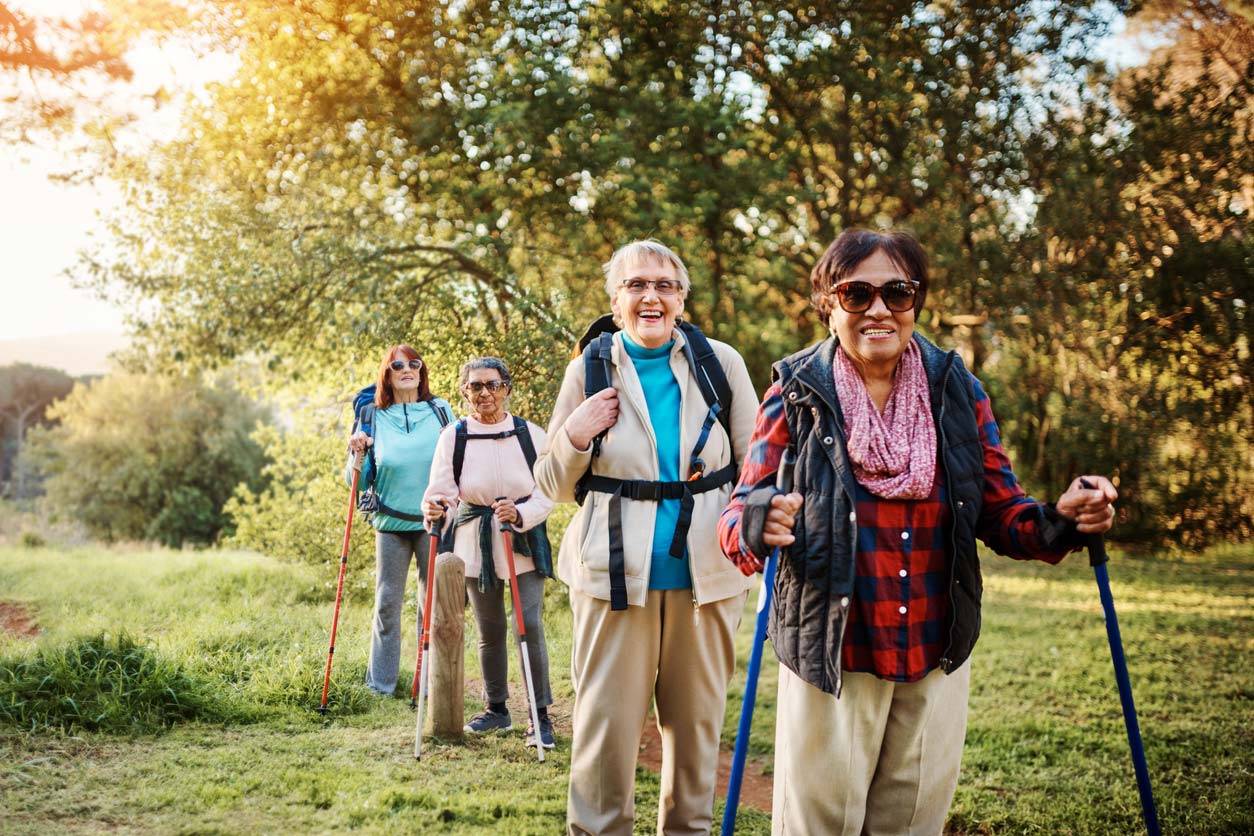
Many factors can contribute to the process by which bones weaken over time.
Some of the factors are out of our control. These include being over the age of 50, being female, being postmenopausal, having a family history of osteoporosis, and having a small frame. Hormone changes that occur naturally with age may also increase osteoporosis risk, specifically the increase in parathyroid hormone, which controls calcium and phosphorus levels in your bones.
There are also some lifestyle factors we do have control over that can contribute to osteoporosis risk. Smoking, leading an inactive lifestyle, being under or overweight, drinking excessive alcohol, not eating enough fruits and veggies, and eating large amounts of protein and sodium, as well as not getting enough calcium, vitamin D, magnesium, or vitamin B12 can all raise your risk for osteoporosis.
Certain medications may also promote bone loss and osteoporosis.
Some of these include:
- Steroids like glucocorticoids
- Proton pump inhibitors (PPIs) to reduce stomach acid
- The class of antidepressants known as selective serotonin receptor inhibitors (SSRIs)
- Some type 2 diabetes meds (like thiazolidinediones)
- Anticonvulsants
- Drugs to prevent blood clots (like heparin)
- And some chemotherapies
If you use one of these medications, and aren’t sure how it may be impacting your bone health, it’s a good idea to have a conversation with your physician so you can make an informed choice.
Pre-existing health conditions can also put you at higher risk for osteoporosis. If you have Celiac disease, multiple myeloma, inflammatory bowel disease, cancer, lupus, or kidney or liver diseases, you may have a higher likelihood of developing osteoporosis. This means that incorporating healthy lifestyle habits — like a nutritious diet and weight-bearing exercise — is especially important for osteoporosis prevention.
How to Prevent Osteoporosis — Or Reverse it Completely

When it comes to preventing and reversing osteoporosis, it turns out there’s a lot you can do. And it all starts with the building blocks of your skeleton (and every other part of your body) — the food you eat.
1. The Role of Calcium in Osteoporosis Prevention
Calcium is the most abundant mineral in your body, and it’s found particularly in your bones and teeth.
Your bones undergo constant remodeling, in which they manage calcium resorption and deposition needed for bone formation and maintenance. As you age, your bones tend to lose more calcium than they maintain, which raises the likelihood of developing osteoporosis. This is especially common among postmenopausal women.
How much calcium do you need? Here are the recommended dietary allowances (RDA) based on age groups:
- 0-6 months = 200 mg
- 7-12 months = 260 mg
- 1-3 years = 700 mg
- 4-8 years = 1000 mg
- 9-13 years = 1300 mg
- 14-18 years = 1300 mg
- 19-50 years = 1000 mg
- 51-70 years = 1000 mg for men; 1200 mg for women
- 71+ years = 1200 mg
Do You Need Dairy to Get Enough Calcium?
For a long time, the dairy industry, aided by government allocation of taxpayer money, has been promoting high calcium consumption as the key to osteoporosis prevention. And they touted milk products as the best source of calcium.
But studies consistently fail to show that a high intake of calcium in a diet helps prevent fractures. Enough is important, but getting more doesn’t seem to help.
There’s no doubt that dairy is high in calcium. In fact, a cup of cow’s milk has over 300 milligrams. So aren’t dairy products correlated with stronger bones?
If that were true, you would expect that in places where people consume lots of dairy — like the US, Great Britain, and Scandinavia — you would find very little osteoporosis. However, when you look at the data, just the opposite is true. Studies have shown that fracture rates are significantly higher among populations that consume higher amounts of dairy, compared to those that consume little to none of it.

Figure 1: A Fitted Line Plot showing the correlation between Hip Fracture rates per 100,000 and Dairy Consumption, using data from 40 countries in Africa, Europe, Latin America, North America, Asia, and Oceania.
Scientific Figure on ResearchGate. Available from: https://www.researchgate.net/figure/A-Fitted-Line-Plot-showing-the-correlation-between-Hip-Fracture-rates-per-100000-and_fig5_304609076
In the Harvard Nurses’ Health Study, researchers tracked 77,761 women between 34 and 59 years of age for 12 years. They found that those who consumed the most calcium from dairy foods were just as likely to break bones as those who rarely drank milk.
OK, so maybe you don’t need dairy for strong bones. And studies tell us that getting large amounts of calcium might not help much, if at all. But getting enough calcium is still a good thing. And there are plenty of plant foods that can do the job.
2. What Sources of Plant-Based Calcium Should You Be Eating?
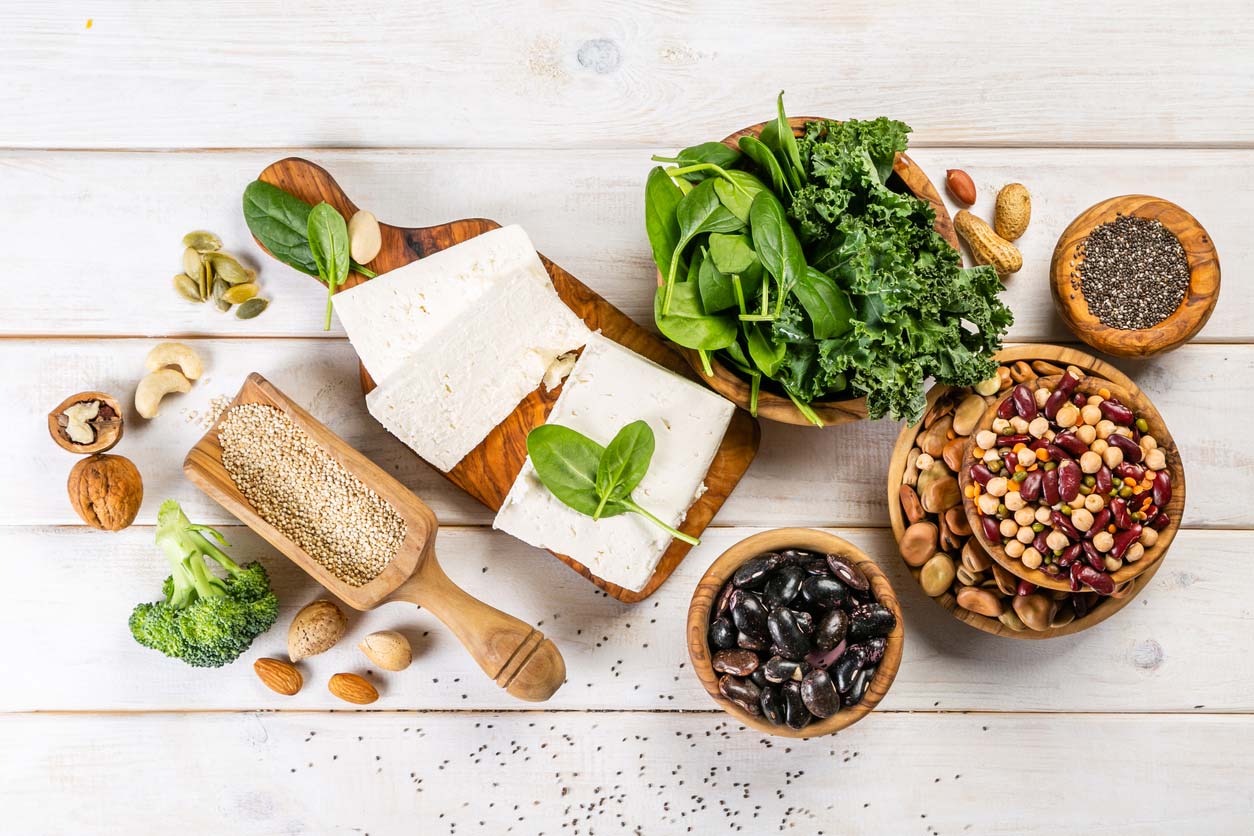
Some of the best plant-based sources of calcium are listed below. Note that all calcium content listed comes from the USDA FoodData Central nutrient database.
- Green Leafy Vegetables
- 1 cup loose kale = 53 mg
- 1 cup mustard greens = 64 mg
- 1 cup romaine lettuce = 21 mg
- Beans & Legumes
- ½ cup canned kidney beans = 45 mg
- ½ cup chickpeas = 80 mg
- ½ cup cooked black beans = 40 mg
- ½ cup cooked lentils = 20 mg
- ⅔ cup green peas = 40 mg
- Broccoli
- 1 cup raw broccoli florets = 35 mg
- ½ cup cooked chopped broccoli = 31 mg
- Whole Grains
- 1 cup cooked quinoa = 31 mg
- 1 cup cooked oatmeal = 21 mg
- 1 cup cooked amaranth = 116 mg
- Dried Fruit
- ¼ cup dried figs = 57 mg
- 5 dried apricots = 20 mg
- 1 box (28 g) raisins = 20 mg
- Seeds and Nuts
- 2 Tbsp chia seeds = 177 mg
- 2 Tbsp sesame seeds = 176 mg
- 1 oz almonds = 75 mg
- 1 oz hazelnuts = 56 mg
- 1 oz tahini = 42 mg
- Soy Foods (go organic to steer clear of GMOs)
- ½ cup edamame = 80 mg
- 3 oz tofu = 150 mg
- 1 cup tempeh = 184 mg
Calcium Inhibitors
Some calcium-rich plant foods also contain oxalic acid, or oxalates, that can inhibit the amount of calcium absorbed from them. Plant foods with the highest amounts of oxalic acid include spinach, rhubarb, chard, and beet greens. Research indicates that calcium absorption may be limited to as little as 5% from these particular greens. However, if you cook chard or beet greens in with other greens such as kale or collards, the oxalic acid in the chard or beet greens is not enough to compromise the value of the calcium in those other greens.
Another compound that inhibits calcium absorption is phytic acid, which is found primarily in beans. Of course, beans are a great source of other healthy nutrients, like fiber, vitamins, and minerals, so their phytic acid content isn’t a reason to avoid eating them. You can reduce phytate content in dried beans by soaking them for several hours, or overnight, before draining and cooking them in new water. Furthermore, extended soaking and cooking of beans also appears to increase the bioavailability of minerals like calcium.
3. What Foods Should You Avoid for Osteoporosis Prevention?
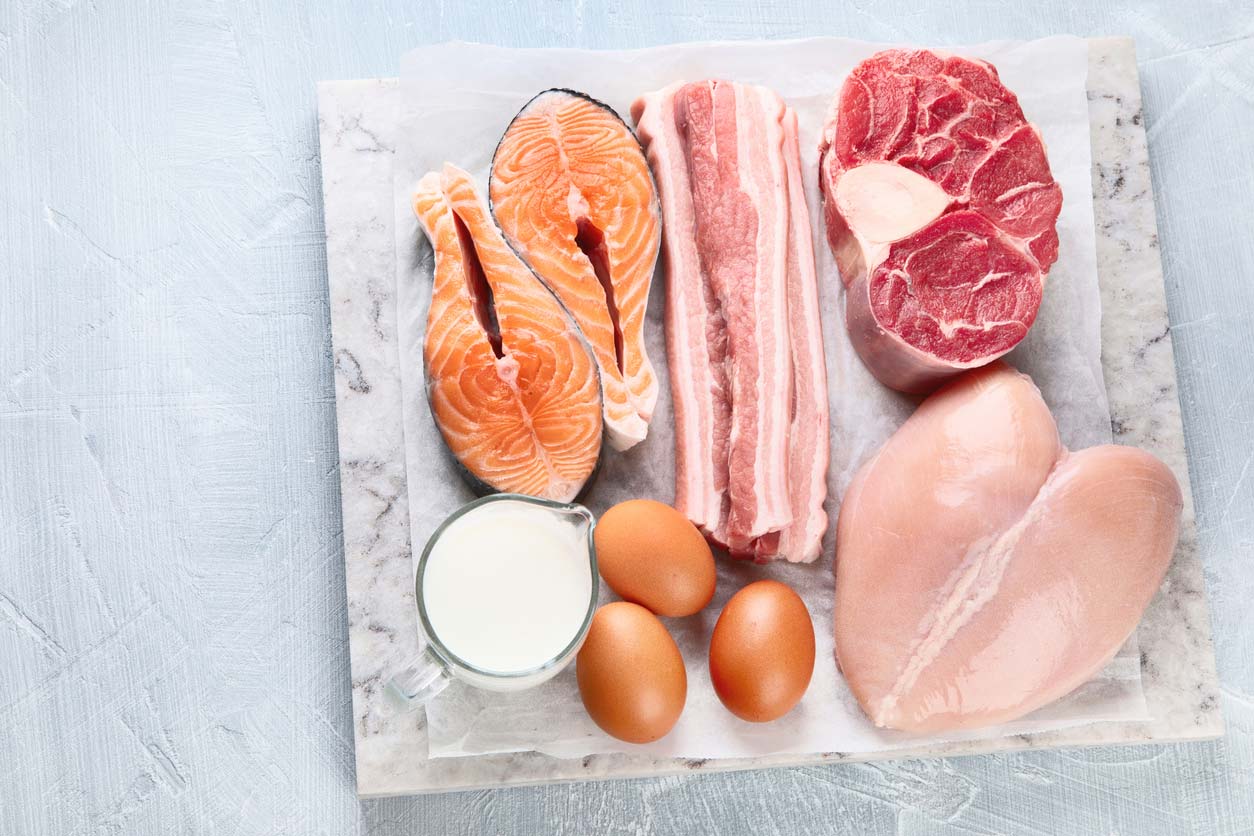
While including a variety of the foods above helps meet your calcium needs, it’s also a good idea to avoid certain foods that could work against your calcium balance. Some foods and beverages may actually promote calcium loss from your bones.
Sodium
Foods that are high in sodium, like fast food and many packaged convenience products, can promote calcium loss. This also means you should avoid adding excessive amounts of salt to food you make at home. Instead, use spices and other salt-free seasonings to add flavor to homemade dishes.
Wheat Bran
Wheat bran is high in phytic acid, which, like oxalic acid found in certain leafy greens, inhibits calcium absorption. Interestingly, unlike beans, wheat bran is the only phytate-rich food that appears to inhibit calcium absorption from other foods eaten at the same time.
Alcohol
Alcohol consumption can also lead to bone loss and increase your risk of osteoporosis. If you drink any alcoholic beverages, keep in mind that they are no friend to your skeleton.
Caffeine
Caffeine can reduce calcium absorption from foods and contribute to bone loss. If you’re worried about osteoporosis, this could be a reason to limit your consumption of caffeinated beverages like soda, tea, and coffee, and to not drink them within two hours of eating calcium-rich foods or taking calcium-containing supplements.
Soda
While soda certainly isn’t a health food, certain types of sodas can contribute more to bone loss than others. In particular, dark colas seem to have the most negative impact. This is due to their higher phosphorus content, which appears to harm bone health when consumed in large amounts, especially if you don’t get enough calcium in your diet.
Animal Protein
Animal foods tend to be higher in sulfur-containing amino acids (methionine and cysteine/cystine). When these amino acids are metabolized, they generate sulfate and raise the diet’s net acid load. In healthy people this doesn’t make the blood dangerously acidic—blood pH stays tightly controlled—but it does increase the acid the kidneys must excrete, often lowering urine pH and increasing urinary calcium loss, an effect usually stronger with animal than plant proteins.
Over time, a persistently high acid load in a low-produce diet may nudge the body to draw on alkaline buffers (including bone minerals), potentially increasing bone turnover. But the extra calcium in urine after higher protein intake doesn’t automatically mean bone is being dissolved, because protein can also boost calcium absorption and bone-building signals (like IGF-1). Big reviews find mixed to neutral effects of animal protein on bone density and fracture risk when overall diet quality and calcium intake are adequate.
Animal-heavy, low-fruit-and-veg patterns raise acid load and urinary calcium; shifting protein toward plants and eating plenty of produce lowers acid load and may be more bone-protective.
How to Prevent Osteoporosis with Lifestyle Strategies

Diet is a big part of the anti-osteoporosis equation, but it’s not the whole story. It turns out that regular physical activity is a huge factor, too.
The best activity for your bones is weight-bearing exercise. This means engaging your body in things like walking, running, weight-lifting, dancing, climbing stairs, and playing tennis. These types of exercise utilize your body weight and encourage maintenance of your bone strength. The strain of muscular activity stimulates your body to shore up your bones. It’s a classic case of “use it or lose it.”
How much exercise is best? Many experts recommend at least 30 minutes of weight-bearing exercise per day, most days of the week.
If you have severe osteoporosis, however, remain prudent. While it’s never too late to start exercising, people with osteoporosis should start slowly. Before beginning a new exercise routine, you may want to speak with your health care practitioner, who might recommend doing a fitness assessment and bone density test to determine the best next steps.
Some of the activities most often recommended for people with osteoporosis include stability and balance exercises, flexibility and weight-bearing aerobic exercises, and strength training exercises that focus on the upper back. If you have advanced osteoporosis, your doctor may refer you to a physical therapist to help ensure your exercise regimen is safe and appropriate before starting.
Whole Body Vibration
Whole-body (or targeted) vibration uses low-magnitude, high-frequency mechanical signals delivered through a platform or wearable device. These gentle vibrations stimulate muscle contractions and provide a small mechanical load to bone. Basically, the platform creates gentle nano vibrations that stimulate your bones and muscles, making them stronger and dense.
It works because when you’re standing on the floor, your bones and muscles are stabilizing against the Earth’s gravity. When you’re standing on a whole body vibration platform, not only are you stabilizing against Earth’s gravity, but you also have to stabilize against the platform’s vibrations. These added vibrations force your bones to work harder, helping make them stronger.
Clinical trials and recent reviews suggest WBV may modestly improve or help preserve bone density, particularly at the hip, and may reduce fall risk by improving strength and balance—though results depend on the vibration settings and overall program, and benefits are generally small to moderate.
Not working out at all can put bones at risk and make them more prone to breaking. And working out too much also puts extra strain on bones by not allowing the body to properly recover.
However, those who work out on a whole body vibration device can work out in half the time without sacrificing the effectiveness of their workout. And the best part is, it’s a convenient option for those who can’t do traditional weight-bearing exercises. Not only is it good for your bones, but it also improves your flexibility, balance, circulation, and overall strength. That means everyday movements will be safer and easier, with less risk of falling and injuring yourself.
Vitamin D
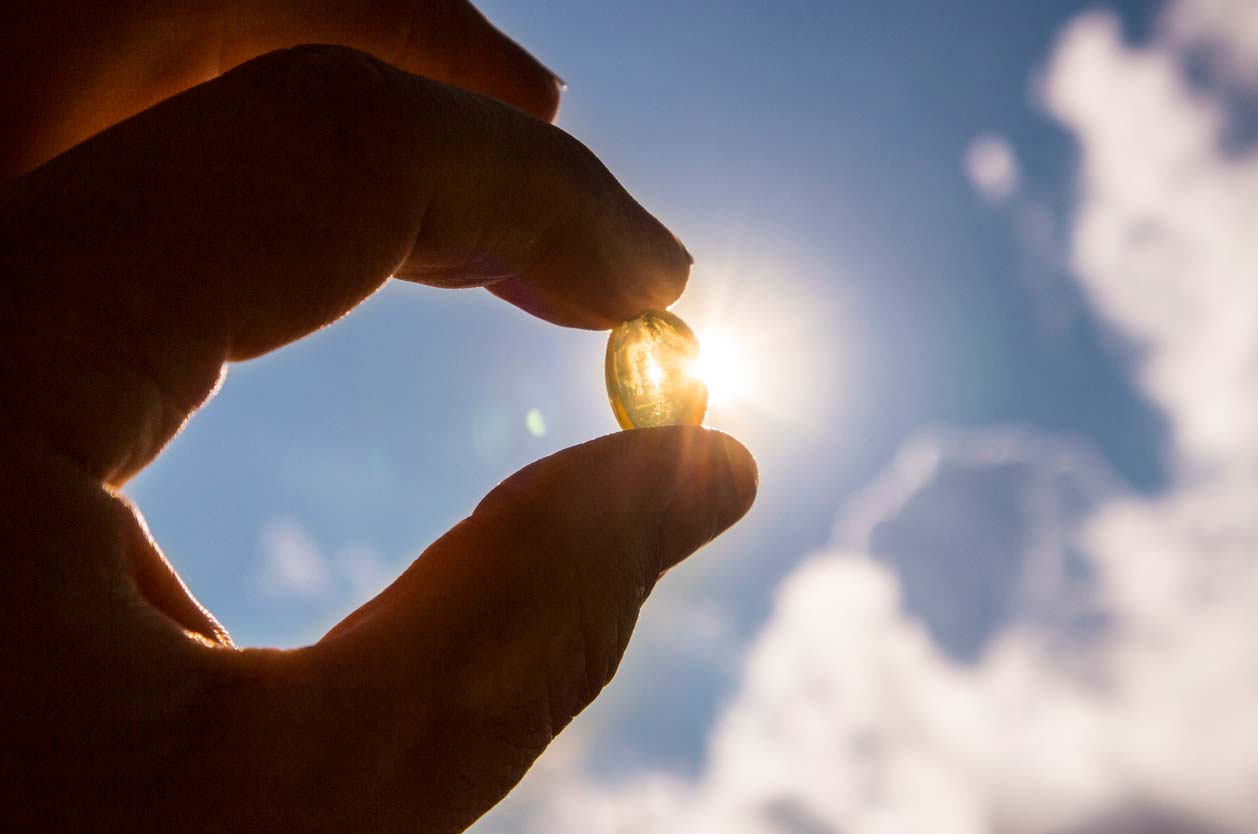
Vitamin D plays an important part in protecting your bones. It’s critical to your body’s ability to absorb calcium, and it also supports the muscles that you need in order to avoid falls. If you don’t get enough vitamin D, you’re more likely to break bones as you age. And excessive vitamin D can also lead to bone loss.
If you’ve never had your serum vitamin D levels checked, it may be a good idea to request a 25-hydroxy-vitamin D test. You can get it done at the same time as other standard blood tests. While recommendations can vary, the Endocrine Society reviewed available studies and concluded that between 40 and 60 ng/mL was optimal for both children and adults. According to this metric, the vast majority of people in the modern world are deficient.
To make sure you get enough vitamin D, there are two main things you can do. First, get plenty of sunlight. Your skin produces vitamin D when exposed to direct ultraviolet light. While recommendations for the best sunlight regimen vary, studies indicate benefits from getting anywhere between 10 and 30 minutes of sun exposure per day, over much of your body. People who live far from the equator (where the sun is weaker), or who have dark skin, may need more sun exposure. Note that tanning beds are not recommended and shouldn’t replace natural sunlight, as they can increase your risk for skin cancer.
Direct, regular sun exposure is not recommended as the primary way for infants and babies to meet vitamin D requirements. Rather, the American Academy of Pediatrics recommends all breastfed babies and children are supplemented with 400 IU of vitamin D daily soon after birth.
If you do take vitamin D supplements on a regular basis, it may be advisable to get your blood levels checked periodically, to ensure you are in a desirable range.
Vitamin D Supplements
Vitamin D supplements for adults are also an option, especially if you get your blood levels checked and find that they are low. A typical supplement regimen for vitamin D maintenance is around 2,000 IU per day of vitamin D3, or cholecalciferol. This amount can often be found in a multivitamin, with a nutrient, or on its own. Some people find they do better with 5,000 IUs, or even more, per day.
Supplementing with calcium and vitamin D, in particular, has been shown to reduce the risk of hip fracture in middle-aged and older women who follow a vegan diet, according to a study that followed 34,000 women and men for an average of eight years. Women who followed a vegan diet and did not take supplemental calcium and vitamin D had about three times the risk of hip fracture compared to nonvegetarians. Without combined supplementation of both vitamin D and calcium, female vegans are at high risk of hip fracture. However, with supplementation, the excessive risk associated with vegans disappeared.
Calcium and vitamin D are foundational for bone health, but supplements aren’t a guaranteed fracture-prevention strategy for everyone. Prioritize food sources first and use supplements selectively (for documented low intake/low blood levels or high-risk groups) in partnership with a clinician.
The USPSTF draft (2024/25) found routine Ca/D supplementation doesn’t reduce falls/fractures in generally healthy older adults living independently. Still, clinical bone-health guidance supports correcting insufficiency and meeting needs.
If you take vitamin D supplements, it’s wise to get your blood levels checked periodically to ensure that you are getting enough and that you aren’t overdosing. Vitamin D is a fat-soluble vitamin, and excessive amounts may build up in the body.
Note that most vitamin D3 supplements come from animal products like lanolin, found in sheep’s wool. However, vegan vitamin D3 supplements are becoming more available and are usually made from lichen, an organism that arises from algae or cyanobacteria. Vitamin D2, or ergocalciferol, is a man-made version that is always vegan-friendly but is not usually as effective at raising blood levels of vitamin D as vitamin D3.
Vitamin K2
In addition to vitamin D, vitamin K also helps to regulate bone health and both prevent, and even treat, osteoporosis. In fact, it works in conjunction with vitamin D to ensure calcium isn’t building up in your blood and organs and is instead making its way into your bones.
One of the clinical markers of osteoporosis and other bone diseases is an increase in osteocalcin levels. Both vitamin K1 and K2 have been shown to reduce osteocalcin levels. And high doses of vitamin K2 have also been used to prevent further bone loss and fractures in postmenopausal women with osteoporosis.
Vitamin K1 is readily available in a number of plant-based foods, including leafy greens, cruciferous vegetables, prunes, peas, parsley and scallions. And many people make vitamin K2 from vitamin K1, in their gut. But this process isn’t efficient in everyone (especially those with compromised gut health).
The main dietary sources of vitamin K2 for some people are high-fat dairy products and organ meats, while plant-based eaters may get it from Japanese fermented soybeans in a dish known as natto, as well as fermented foods such as tempeh, sauerkraut, and kimchi.
Since conversion of K1 to K2 is variable, and there’s no widely available blood test to ensure that you’re getting enough K2, it’s possible that some plant-based eaters may benefit from a K2 supplement. And because of the interplay between vitamin D and K2, taking them together, or in a single supplement, may be the most beneficial to help prevent, slow, or reverse osteoporosis.
Low doses of K2, in the form MK-7 (around 50 mcg/day) are biologically active and can help maintain vitamin-K–dependent bone protein status, but trials show stronger improvements in bone markers at 100 mcg/day or more. Most studies looking at bone density use higher MK-7 doses (typically 90–180 mcg/day), so 50 mcg/day is best viewed as a maintenance dose rather than a therapeutic one.
Sports Research also makes an affordable vitamin D3 (5,000 IUs) plus the MK-7 form of K2 (100 mcg). Find out more here.
Vitamin B12
Vitamin B12 deficiency may also increase the risk of osteoporosis. A condition called pernicious anemia — caused by either inadequate intake of vitamin B12, or insufficient uptake of the vitamin due to a lack of intrinsic factor in the gut — is a risk factor for osteoporosis. Studies have found that B12 deficiency is especially a risk factor among elderly women. And providing supplementation to patients who have severe osteoporosis and pernicious anemia causes significant improvement in bone health. Even though women are at an overall higher risk for osteoporosis than men, a 2005 study determined that men are at equal risk for low bone mineral density if they are deficient in B12. Although more research is necessary on the correlation between vitamin B12 and bone health, it does appear that B12 deficiency can raise your risk for bone loss.
While vegans and vegetarians are at higher risk of not getting enough B12, studies show that many omnivores are deficient, too. In fact, researchers at Tufts University concluded that 40% of all Americans are deficient in B12. Fortunately, it’s easy and economical to add a B12 supplement to your diet.
Additional Supplements
Calcium. If diet doesn’t reliably provide enough calcium, a modest supplement can help fill the gap. A practical evidence-based option is calcium citrate malate providing about 400–500 mg of elemental calcium per day, taken with food. Because absorption tops out around 500 mg elemental calcium per dose, higher supplemental amounts should be split into two doses. CCM is well absorbed and has performed at least as well as calcium carbonate in trials for slowing postmenopausal bone loss.
Creatine. Creatine monohydrate is one of the most studied supplements for preserving muscle as we age. After muscle stores are built up, research and clinical guidance describe a maintenance range of about 2–5 grams per day, with a 2-gram daily serving as a conservative, low-end maintenance dose. Creatine consistently improves strength and lean mass in older adults when paired with resistance training — which may indirectly support bone health by reducing frailty and fall risk. Evidence for direct increases in bone density is mixed, so creatine is best viewed as a muscle-and-function support that complements (not replaces) weight-bearing exercise and a bone-supportive diet.
Magnesium. If diet doesn’t cover magnesium needs, a gentle option is magnesium bisglycinate providing about 150–200 mg of elemental magnesium per serving, taken once or twice daily as needed. This amount matches the typical elemental magnesium found in well-tolerated glycinate/bisglycinate supplements and stays comfortably below the 350-mg/day UL for supplemental magnesium for most adults.
Boron. Typical supplements provide small, trace-level amounts of elemental boron — usually 0.15–6 mg per day — in forms such as boron citrate or amino-acid chelates. A 2 mg daily serving (as boron citrate-glycinate chelate) is a conservative, food-level dose within the common supplemental range.
Zinc. If intake is low, a modest supplement can help fill the gap. A serving providing about 5–10 mg/day elemental zinc fits within the common low-dose “maintenance” range, contributes toward the adult RDA (8–11 mg/day), and stays well below the 40-mg/day UL.
Healthy Habits Support Healthy Bones
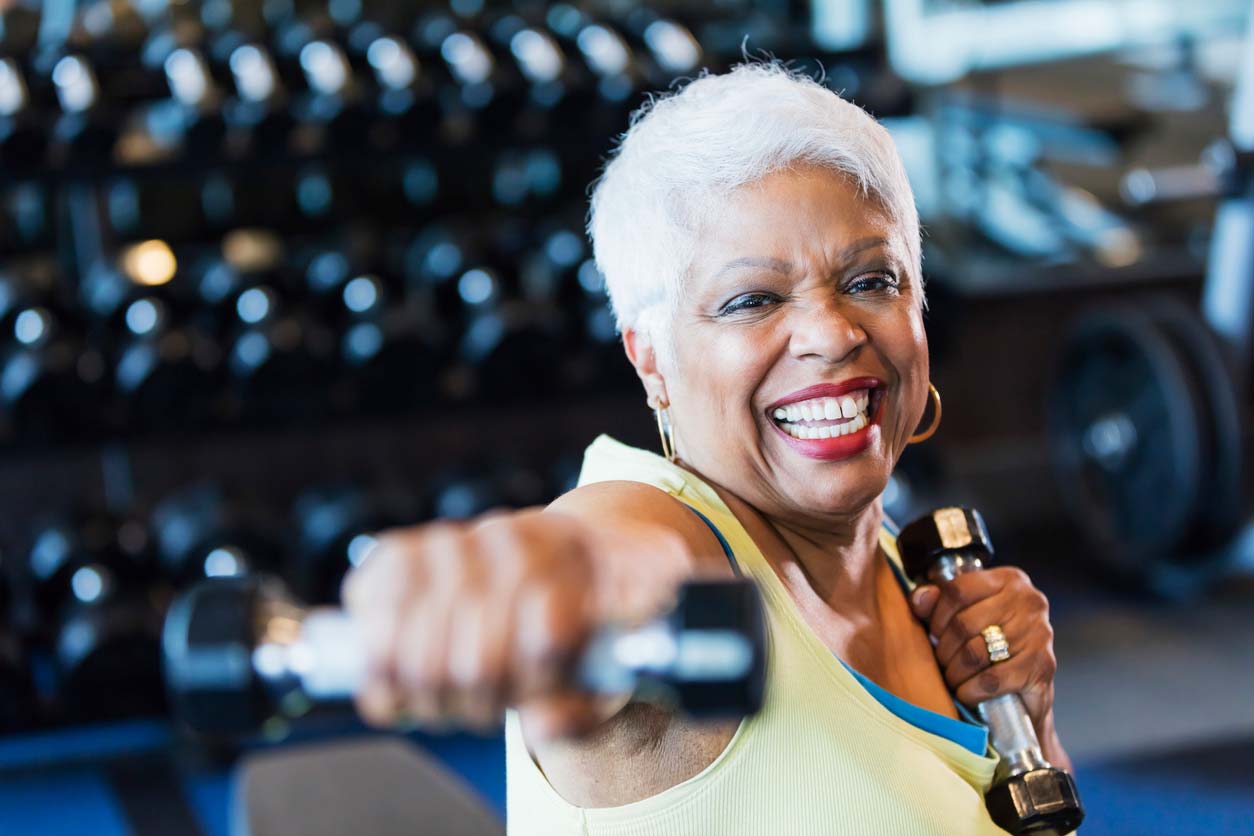
Osteoporosis is a very common condition, but even having risk factors doesn’t mean you can’t do things to minimize your likelihood of developing it. Choosing calcium-rich, whole plant foods, incorporating regular, weight-bearing exercises, enjoying a healthy dose of sunlight, and supplementing where necessary are great habits to adopt. If you have an existing medical condition, take medications, or are struggling with habits that may be putting you at a higher risk for poor bone health, speak with your health care provider about how to best support your skeleton, so your skeleton can continue to support you.
3 Recipes to Help Strengthen Bones and Prevent Osteoporosis
If you really want to maximize your calcium and overall bone-supporting nutrient intake, consider starting with the Creamy Vanilla Cinnamon Chia Pudding for breakfast, which includes rock-star ingredient chia seeds. Then, move to the 12-Ingredient Superfood Salad Bowl for lunch with calcium superstars kale and edamame. Finally, end the day with Kung Pao Tofu and Broccoli with calcium-rich… Well, can you guess the calcium stars here? (Hint: It’s in the name!)
1. Creamy Vanilla Cinnamon Chia Pudding
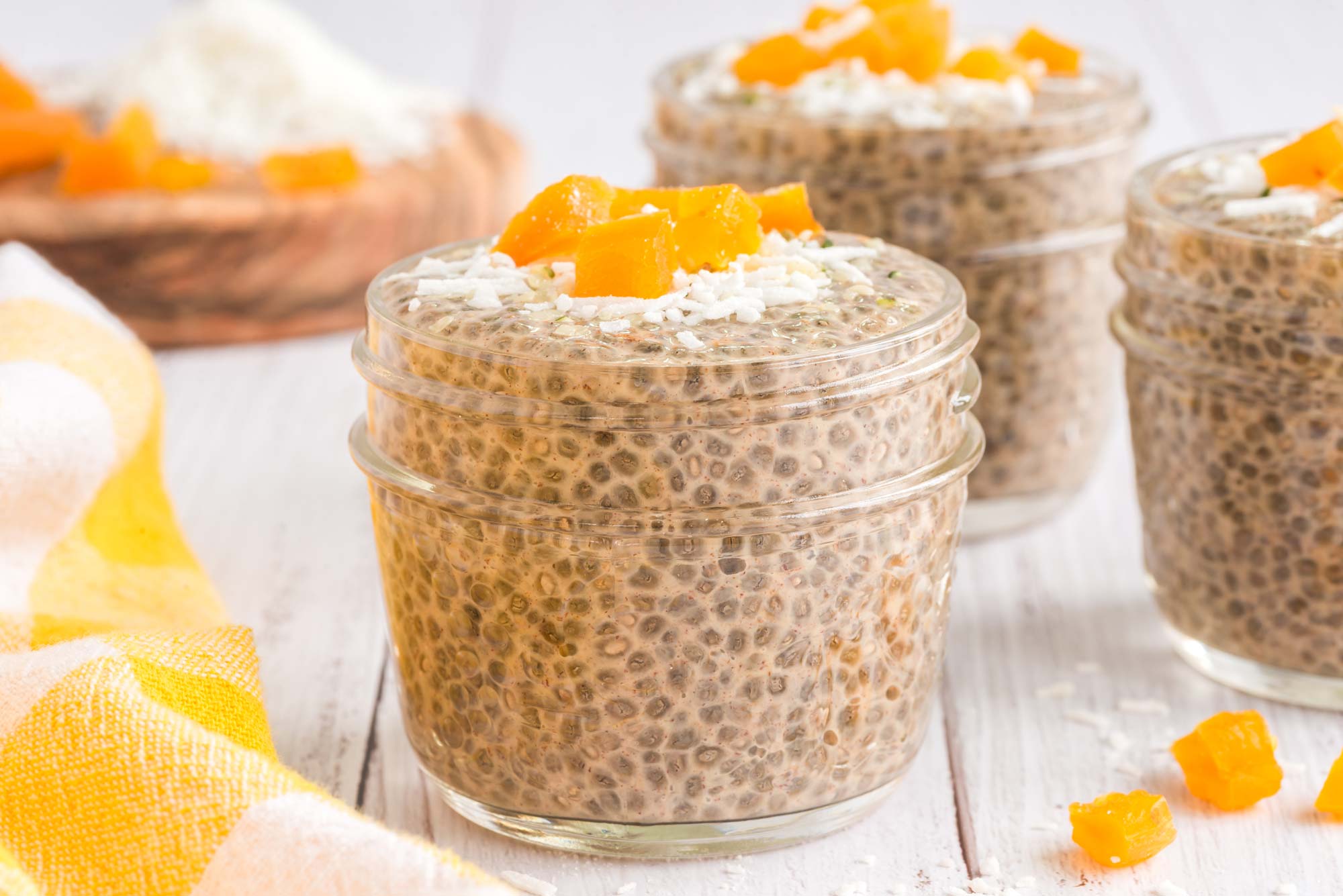
Fun fact about chia seeds (in case you missed it above): they have a whopping 177 mg of calcium in just two tablespoons! When it comes to nuts and seeds, chia seeds are powerhouses. This chia pudding for two offers all of that calcium and more! Add some plant-based milk to it, and you have yourself a delicious bone-building treat.
2. 12-Ingredient Superfood Salad Bowl
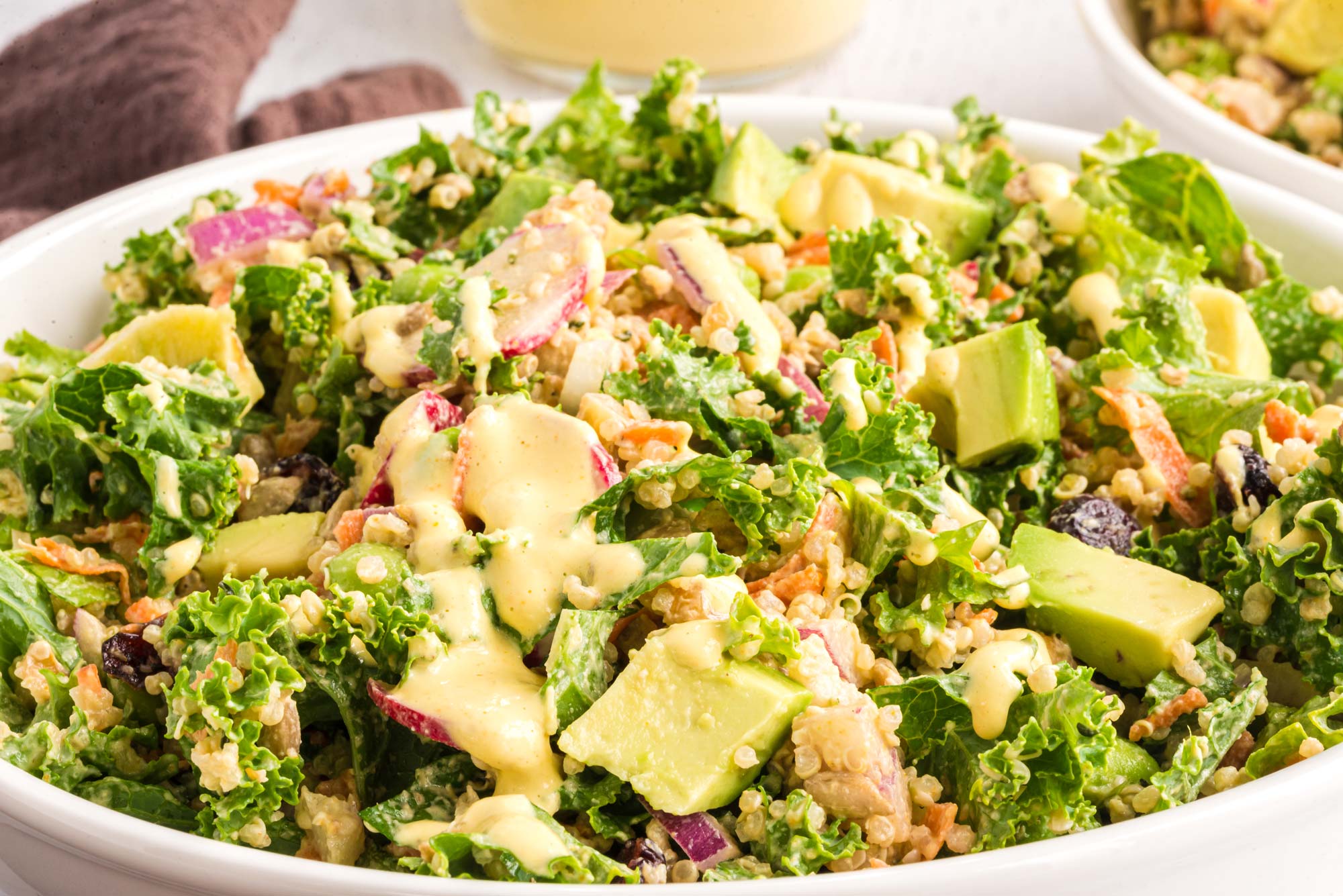
How many bone-building nutrients can you successfully squeeze into one bowl? A lot! While kale and edamame stand-out as nutrition heroes given their calcium content, this salad is also packed with magnesium from nuts and seeds and protein from hemp and walnuts — both of which are essential nutrients for supporting bone health.
3. Kung Pao Tofu and Broccoli
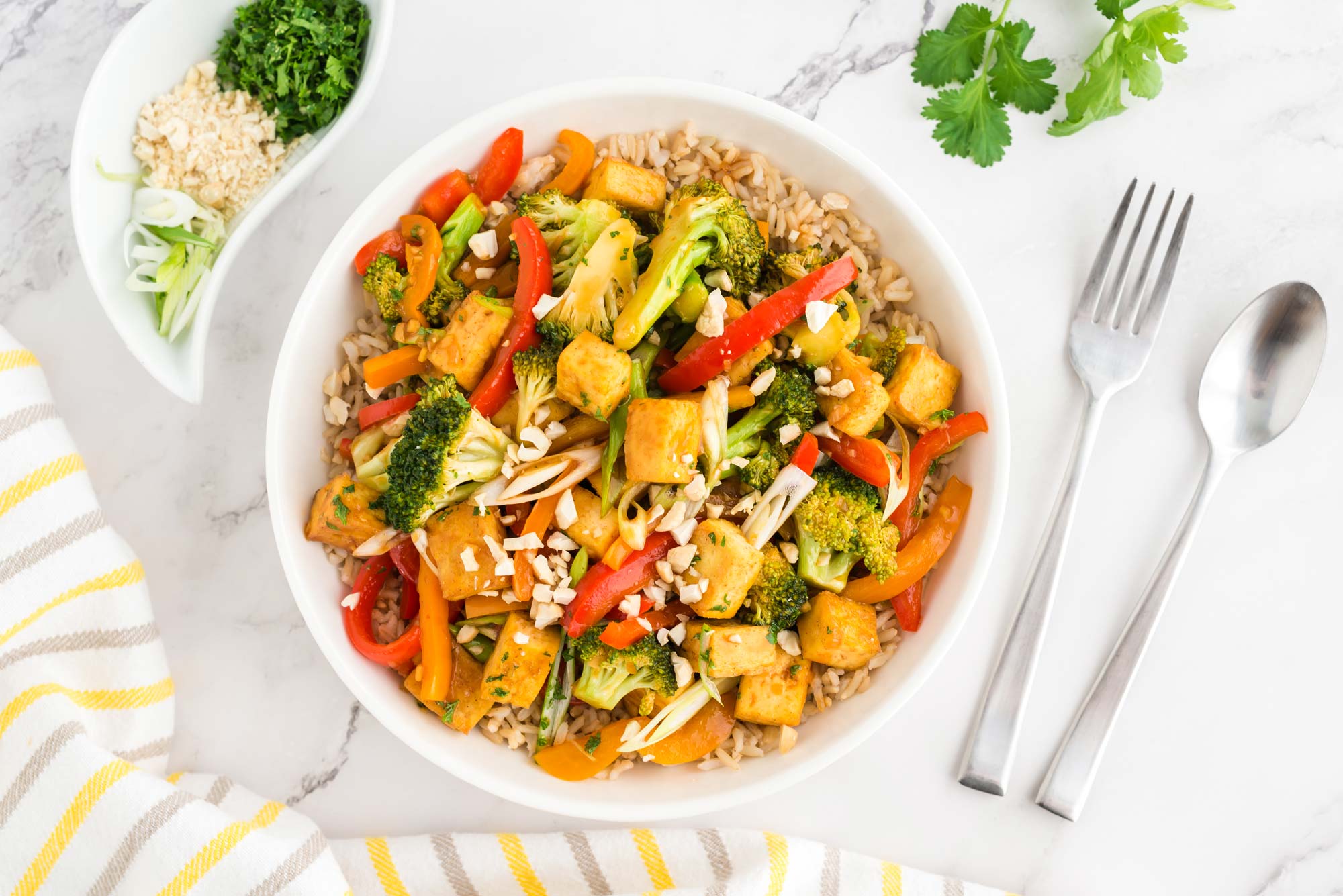
Not only is this dish simple to make and bursting with flavor, but it’s also jam-packed with calcium given the two stars of the show, organic tofu and broccoli. Sprinkle some sesame seeds on top for an extra calcium bonus!
Take Care of Your Bones
While the risk of osteoporosis and bone loss increases as you age, you can help prevent it, and in some cases, reverse its course by paying special attention to lifestyle factors such as diet and exercise. In particular, plant foods high in calcium, vitamin D, and B12 will strengthen and maintain bone health. Even if you don’t currently have osteoporosis, a little bit of prevention now can go a long way in ensuring a healthy future.
Tell us in the comments:
- What are your favorite calcium-rich plant foods?
- Do you make any lifestyle choices with osteoporosis prevention in mind?
Feature image: iStock.com/quickshooting

